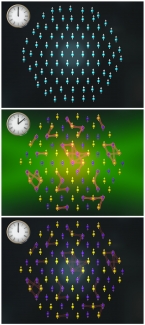JILA and NIST scientists are hot on the trail of understanding quantum correlations (or entanglement) among groups of quantum particles such as atoms or ions. Such particles are the building blocks of larger and larger chunks of matter that make up the everyday world. Interestingly, correlated atoms and ions exhibit exotic behaviors and accomplish tasks that are impossible for noninteracting particles. Therefore, understanding how entanglement is generated in those systems is not only central to comprehending our world, but also advancing technology.
The development of a new experimental method to measure quantum correlations between particles was the focus of a recent collaboration between Ana Maria Rey’s theory group at JILA and NIST experimentalist John Bollinger’s group. The two groups worked together on an experimental study of quantum correlations in a trapped-ion magnet consisting of ~100 beryllium (Be+) ions. The Rey group’s theory predicted that the experimenters could measure the build up of entanglement caused by the interactions between the ions by illuminating the ions with lasers that allow the ions to interact going forwards and then backwards in time. These steps were followed with an examination of how much the ions resembled the state they were in before their time traveling adventure.
So what exactly happened in this experiment?
Imagine that the ions were like magnetic cars racing on a very icy route. The result would be lots of accidents. Because the cars were magnetic, a multi-car collision would result in several cars getting stuck together, forming larger clusters of wrecked cars. The icy route in this analogy is like the vibrations of the ion crystals in the experiment. These vibrations mediate interactions between the ions.
In actuality, the ions in the experiment were set up as if each car were driving in its own lane on the icy road. The ions (cars) moved forward for some time, then backwards for the same amount of time. In the absence of icy conditions (i.e., without interactions), the cars would return to their initial position after going forwards and backwards. However, if the road were icy, two, three, or more ions (cars) might collide and form larger clusters. In the experiment, the system did not return back to its initial state. In fact, it became very different. Clusters of ions became correlated. Furthermore, as the ions became correlated, information about their individual properties got lost or scrambled.
Curiously, the researchers only identified groups of eight correlated ions in their measurements, rather than a hundred-ion pileup. The reason is that entanglement between ions is quite fragile. Entanglement can be destroyed by quantum processes collectively called decoherence. Decoherence is induced by laser beams––the same laser beams that excited the vibrations in the crystal in the first place and made the ions interact. It’s as if the decoherence “demagnetized” the cars (ions). When collisions happened between demagnetized cars, the cars (ions) could still change the direction of their motion, but they couldn’t stick together. If they couldn’t stick together, they weren’t able to form big clusters. But in the experiment with the Be+ ions––even with decoherence––the researchers still observed the build-up of eight-body correlations.
“The most interesting aspect of this story was that the quantities that we were measuring were something unique,” Rey said. “Then we heard a talk about black holes and their connection to quantum chaos. The idea was that black holes are the objects which erase, or scramble, information at the fastest rate allowed by nature.
“Information is rapidly scrambled by a black hole because it’s a hot, crazy system. The high-energy community was proposing a way to quantify how fast information is scrambled in a black hole by measuring a very complicated correlator. But this correlator was exactly what we were measuring in our experiment.”
One difference is that in contrast to black holes, Be+ ions lose information slowly enough for the researchers to watch the process as ions become correlated. It’s also important to realize that the trapped-ions experiment showed for the first time that laboratory measurements of these correlations are possible and can provide unique information about the build up of entanglement.
“In fact, entanglement may be the common language that explains the behavior of very different systems in nature, including ions and black holes,” Rey said.
The researchers responsible for this provocative new theory-experiment collaboration include former research associate Martin Gärttner (currently at the University of Heidelberg), research associate Arghavan Safavi-Naini, former senior research associate Michael Wall, NIST scientists Justin Bohnet and John J. Bollinger as well as Fellow Ana Maria Rey.––Julie Phillips




